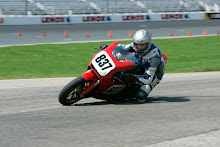
One of the little issues we knew would have to be changed on the bike were the carbs. It's not like I could mistake it; it seemed there was an endless stream of bearded gentleman passing by my bike in the paddock pointing out things like, "You know, those forks are illegal," and, "Oh, you can't use flatslide carburetors, you're going to have to change those," usually delivered with a sly smile. Every once in a while one of these gentleman would get a little too insistent, and I would round on him, with, "Sir. This is a 1982 Formula 2 racebike. Lectron flatslides became available in 1979. All the cool BMW R90S riders discovered them as the 80's dawned, and ditched their Dellorto squirtguns. The Mikuni flatslide -which these are- is a pretty close copy of the Lectron. While flatslides may be inappropriate for the earlier vintage classes, anyone trying to disallow them for Period IV F1 & F2 merely lacks historical perspective." Whoever I was talking to would suddenly get that unmistakable I-think-I-left-the-kettle-on look and shuffle quickly away. Now, I worked in a BMW shop back for a while in the mid-80's, and I also knew that most of the reason that the BMW riders put Lectrons on their bikes was for the look. An R90S is all beautiful curves, and those flatslides looked like rough square blocks of aluminum tacked on behind those lovely cylinders. It's not like they were any real advantage, and were, by all accounts, a complete bitch to tune. So, by mid-season, I had bought a tired and filthy set of Dellorto PHF36 carbs from Ed Milich for rebuilding. The PHF36 is the traditional Pantah carb, and it has an accelerator pump that will shoot a stream of raw gas about 20 feet across the shop of you snap the throttle with the carb out of the bike. Hence, a squirtgun. It's also endlessly adjustable, and has more tiny parts than a Swiss watch. . . many of them made of rubber, and needing to be replaced, and very, very expensive. And the carbs sat, in their box, on the shelf, for months. In late December, Steve Allen, the proprietor of Bevel Heaven (specializing in all things vintage Ducati), had a sale, but the order had to be in before January 1. The ball wasn't actually dropping when I finally sat down at the computer and forced myself to face the inevitable, but Times Square was already pretty crowded.
So, about $300 worth of tiny rubber and brass parts arrived in a small envelope a few days later, and I got to work on the old carbs I had bought. Carefully, carefully, disassemble, label, describe, bag, arrange, file. . . because nothing, nothing can help you if you forget which tiny screw, which miniscule o-ring goes where, and they're all different. And all the new parts come jumbled (from Dellorto) in a little sealed bag, no list, no diagram, no description. Dip the old metal parts in the carburetor cleaner, scrub away with the old toothbrushes you've been faithfully collecting. Clean them all with hot, soapy water, carefully rinse, and even more carefully, blow them dry with compressed air. . . and if one tiny bit blows out of your hand, well, there goes another $20 or so.
At last, the carbs were done and clean (see the before and after above!). When we were over at Bruce's cutting down the brake caliper pistons, he scribbled the proper jetting on the side of the box I'd carried the calipers in, and I duly ordered another $100 or so in jets and other oddments from Steve. Everything was assembled: carbs, new cables (Motion Pro, custom made for Steve), and a new Tomaselli Daytona 1/4 turn throttle. Put it all together, put it on the bike, all ready to go, and- what? Why won't the slides close? I took the carbs back apart. I took the throttle apart. I put them all back together. 4mm shy. A week of terse (and tense) emails passed between Steve and I. I like Steve a lot. We've done a fair bit of business together, and he's got great stuff. But I was crazed. Everything was put together perfectly, and it just wouldn't fit. "What's up with this throttle- why does it take up so much cable at rest?" I checked everything, and sent Steve all the measurements- and everything measured correctly. We were both exasperated. Steve said, "Box it all up. Send it to me." Off it went. A few days later, the phone rang. Steve was laughing. The cable-end sockets in the throttle casting weren't drilled to the proper depth at the factory. Now, be serious! This was the only solution I had been able to come up with, the only thing that made any sense at all, but it was still nonsense. Before Steve had called me, he had drilled the sockets out to the proper depth, checked the carbs over (I'll get at least another season out of the slides, thankfully!), set the throttle stop, and gotten them packed and ready to send. Probably went out today, and hopefully, I'll see them for the weekend.
In the end, I spent more buying a tired old pair of carbs and rebuilding them than I would have paid for brand-new ones, but, unlike a lot of racers, if something goes wrong in my fuel system during a race day, I'm the one I need!


